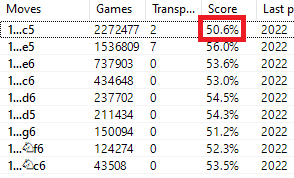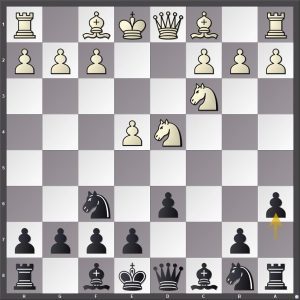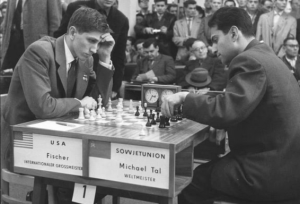The charm of the Sicilian Defense
After 1.e4, more than 39% of the games follow the lines of the Sicilian Defense. This popularity is well-founded, as the adepts of the Sicilian are rewarded with a win-rate of 50.6% (from White’s perspective). This is extraordinary, taking into account that the benchmark ranges around 54%.

I can detect four reasons for this good performance:
1. There are some high-quality lines for Black in the Open Sicilian
2. Many white players are intimidated by the complexity of the Open Sicilian and opt for substandard sidelines.

As you can see, the results are generally very poor for White and often below 50%. 2.Ne2 appears to by an outlier, but it is used by specialists (strong players) and often transposes to the Open Sicilian after a subsequent d2-d4. As I commented in an earlier post, the Sicilian Defense has the advantage of providing the opponent with “negative flexibility” by leading to a position with many low-quality options for White.
3. The immediate asymmetry after 1.e4 c5 allows strong black players to play for a win, thus unfolding their full potential. This leads us to the next point.
4. As the Sicilian Defense is especially attractive for strong players, the player quality behind 1…c5 is higher than it is the case with alternative moves. This of course, leads to a certain distortion of the statistics. Feel free to mentally discount this “expert-effect”, as I coined it earlier in this blog, from the objective quality of the move 1…c5.
Il capo di tutti i capi

After having established that the Sicilian Defense is the best option if you want to win with Black against 1.e4, due its complexity and metagame characteristics, we now have to search for quality within the sicilian universe. I assume, you are also interested in having the best of both worlds (winning potential combined with quality).
As far as I know, the most promising Sicilian lines are the combination Four Knights/Shveshnikov and the Najdorf Variation. While the Shveshnikov is a pretty rustic approach, banking on active piece play and its drawing potential through opposite colored bishops, the Najdorf is a far more elegant weapon with a complex interaction of pieces and pawn play. Choosing the Najdorf is like fighting 1.e4 with a lightsaber.
What is the reason for the success of the Najdorf Variation? What makes it superior to most of the other Sicilians? The answer is the combination of flexibility, activity and harmony.

One of the tenets of the flexibility principle is to distinguish between essential and arbitrary aspects of a position. Play what is essential, what has to be done anyways and leave the optional elements for later. This gives you the room to adapt to your opponent’s play and also disguises your intentions. The move …a6 is necessary or valuable in most cases. By playing this essential move first, Black keeps all his options open, regarding the following:
- Placing the knight on d7 or c6
- Playing the e-pawn to e6, e5 or leaving it on e7, in case of …g7-g6
- Moving the dark-squared bishop to e7, g7 or leaving it on f8 for a longer period of time
- Putting the light-squared bishop to b7, e6 or d7
- Placing the queen on c7, b6, a5 or leaving it on d8
Activity is represented by a frequent occurrence of the moves …e7(e6)-e5, …b7-b5 and …d6-d5. Sometimes we see one of these thrusts happening, more often two of them and in some occasions even all three. In many lines the light-squared bishop can be actively placed on b7, from where it exerts strong pressure against White’s e-pawn. Activity is also displayed in other Sicilians, but not in such a perfect combination with flexibility and harmony.
The manifestation of harmony can be seen in the common placement of the queen’s knight on d7. There, it doesn’t interfere with the bishop on b7 or the rook on c8. Furthermore, it has options on c5 (adding pressure against the pawn e4) as well as on b6 and e5 (preparing a jump to c4), which adds to the flexibility of the position.
By following the principles of flexibility, activity and harmony, the Najdorf has a lot in common with the Hedgehog-setup. However, the live of the Hedgehog player appears to be a bit more difficult with White’s pawn being on c4.
The benefits of playing the Najdorf
Every Najdorf player is member of an exclusive club headed by the likes of Tal, Fischer and Kasparov. Wielding the same powerful weapon as these giants did, might give you a good feeling, knowing that not everyone is able to handle it. Compare it with riding a motor bike, sports car or mastering a fighter jet, if you like. In any case, experiencing the richness of the positions will provide you with a lot of aesthetic pleasure, especially, if you fully understand what’s going on. By contrast, if your opening repertoire is composed of too many shallow lines, you might suffer from boredom and a lack of motivation.

Exclusivity comes with a price. Of course, it needs a lot of effort to learn the complex Najdorf Variation. These high barriers of entry is what makes the Najdorf exclusive. But everything has to be put into perspective. Let’s sum up all of the advantages:
1. High quality
2. High winning potential
3. Aesthetic pleasure
4. Sustainability
You can play the Najdorf forever. Unlike substandard openings, which provide you with many experiences of frustration, you don’t have to ever discard it. Hence, in the long run you even save time and are far better off compared to the multitudes of variation hoppers.
5. Improving your chess understanding
Learning the rich positions of the Najdorf is like a fundamental course on middlegame strategy. As they say, life starts outside of your comfort zone. The Najdorf has the potential to transform you into a different kind of player.
Is the Najdorf for me?
As the Najdorf is difficult and time-consuming, you should check your characteristics and resources before embarking on this exiting adventure. In my opinion, the following features are helpful:
- Your are not a mere classical player, but have knowledge of modern chess strategy.
- You already play the Sicilian Defense.
- You are ambitious and willing to work seriously on your chess.
- You love to win and don’t suffer too much from loss aversion.
Should you happen to need assistance with your own Najdorf repertoire, I won’t let you standing in the rain.
